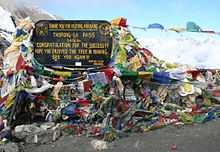Thorong La
| Thorong La | |
|---|---|
 | |
| Elevation | 5,416 m (17,769 ft) |
| Location |
|
| Range | Himalayas |
| Coordinates | 28°47′37″N 83°56′14″E / 28.79361°N 83.93722°ECoordinates: 28°47′37″N 83°56′14″E / 28.79361°N 83.93722°E |

Thorong La or Thorung La is a summit pass located 5,416 metres (17,769 ft) above sea level in the Damodar Himal, north of the Annapurna Himal, in central Nepal. It connects the village of Manang (3540 m), in the Manang district to the east, with the temple of Muktinath (3800 m) and the village of Ranipauwa (3700 m), to the west in the Mustang district. It is regularly used by local traders.
Tourism
Thorong La is the highest point on the Annapurna Circuit, a 300 km (190 mi) trek around the Annapurna mountain range. The pass is high enough to cause Acute Mountain Sickness (AMS) in trekkers who have not acclimatised to the altitude. While it is possible to cross Thorung La from Manang to Muktinath in one day, the doctors of the Himalayan Rescue Association (http://www.himalayanrescue.org/) post in Manang recommend that trekkers spend five nights between their arrival in Manang and the crossing, although two or three nights are usually enough.
The safest seasons with a clear weather window for crossing the pass is between March and April and between October and November. Attempting to cross the Thorung La in winter is dangerous due to avalanches, the risk of frostbite and the chances of losing one's way in the snow.
Most tourists cross the pass from east to west (Manang to Muktinath and Ranipauwa), which is the easiest and safest direction. Before the pass, trekkers can spend the night either in Thorung Phedi (at 4420 m) or at Thorong High Camp (4800 m), meaning that they will have to climb a maximum of 1000 m and descend about 1,600 m (5,200 ft). The way from Muktinath does not offer opportunities for altitude acclimatisation, with the last spot where it is possible to spend the night being at 3700 m (Ranipauwa, all year round) or at 4200 m (Muktinath Pedhi with a very basic seasonal lodge), meaning that a trekker going from west to east will have to ascend 1700 m or 1200 m and descend at least 600 m in one day.
If crossing the pass in October/November, an early start (at least a few hours before sunrise) in going over the pass is recommended as strong winds typically begin a few hours after sunrise.
Local climate
The local climate on the western side of the pass is much drier than on the eastern side. There is practically no vegetation on the western side, except where irrigated, while in the Manang valley (East) there is much more vegetation and cultivation is possible, while it is still fairly dry, as the valley is protected from the wet southern monsoon winds by the Annapurna mountain range.
References
- Stan Armington, "Trekking in the Nepal Himalaya". Lonely Planet, 2001.